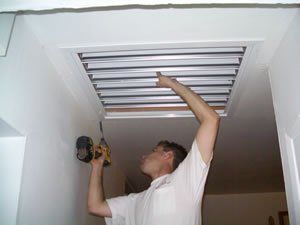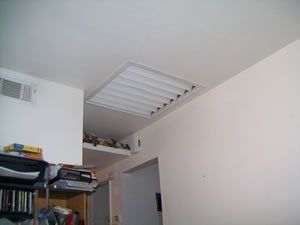Cooling Solutions
Whole House Fans
What is a Whole House Fan?
A Whole House Fan is a mechanical/electrical device used to pull air out of an interior space; usually located in the highest location of a building, in the ceiling, and venting to the attic or directly to the outside.An Old Idea Whose Time Has Come
Before there was air conditioning, homes were cooled by relying on Mother Nature. Such things as shade trees, roof overhangs, and the orientation of the home itself all played an important role in maintaining a home's livability during hot summer months. Whole house fans were often used to replace hot, stale inside air with cooler outside evening air drawn through open windows and doors. But with the advent of air conditioning systems, these low-cost cooling methods, including the use of whole house fans, were gradually reduced to secondary strategies. Now, with energy costs becoming increasingly important, people are taking a second look at these and other methods to reduce energy costs. Hence there is renewed interest in whole house fans.

Whole House Fan = A Smart Investment
Whole house fans are inexpensive, even when professionally installed. They usually pay for themselves in a few short seasons. For cost- effective cooling, they're hard to beat. For more information, ask your local retailer or contractor or call SMUD at 1-888-742-SMUD(7683) or visit SMUD web site
Selecting a Whole House Fan*
Contact Us Today!
Choosing the whole house fan that's right for you will depend upon your needs and the features you prefer. Whole house fans are characterized most often according to the volume of air they replace in cubic feet per minute (CFM) and by their drive mechanisms- direct drive or belt drive.
A fan properly sized for your home can make a complete air exchange in about 2-3 minutes. Five to ten air exchanges will cool not just the air, but the walls and furnishings as well. Those things contribute to heat buildup by absorbing heat throughout the day and releasing it at night. Running a whole house fan for about 20 minutes will cool these things sufficiently to make your home comfortable.
Most standard whole house fans move between 2,500 and 6,800 CFM of air, depending upon such factors as fan blade size, opening size, and available net free venting.
To determine the volume of your home in cubic feet, take the floor area in square feet and multiply that by the height of the ceilings. For example:
an 1,800 square foot home with an 8 foot ceiling height has a volume of 14,400 cubic feet. If you wish to replace that volume of air in, say, three minutes, you would require a whole house fan rated at 4,800 CFM. A higher CFM rated fan will replace the air in less than three minutes, while a lower CFM rated fan will replace the air in more than three minutes.

*Avoid Back drafts
Care should be taken to avoid backdrafting combustion appliances that are installed in the conditioned space. It is strongly recommended that combustion appliances NOT be installed in such a manner that they use room air for combustion. The whole house fan is capable of pulling large quantities of air from the home and particularly if not enough windows are open, may easily back draft a water heater located inside a louvered closet door.
Follow Us
(916) 801-4396Northern California
Whole House Fans &
Radiant Barrier
(916) 801-4396
A JDM Construction Company
Sacramento, CA
Website Design By:
Calvin Barajas
(650) 463 Six-Zero-One-Zero

